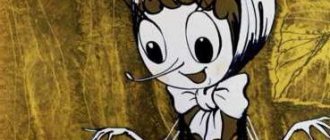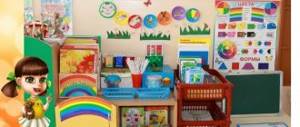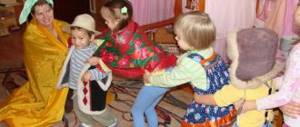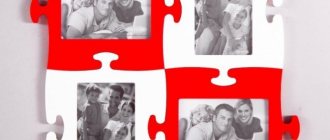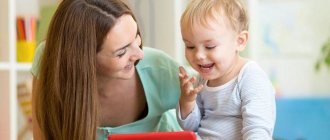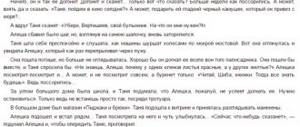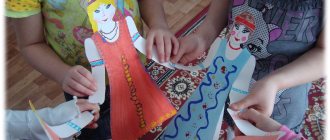Progress of the game: Children are located freely around the hall.
Music A (loud)
– Children clap their hands loudly and jump or perform a spring.
Music B (quiet)
- The children crouch and clap their hands quietly.
For a more complicated version, you can use bells, sticks or rattles instead of claps.
Musical communication game
GAME “THE TOY SLEEP AND DANCE”
Goal: Development of ideas about the 2-part form.
Equipment: CD with music , toys (soft toys, rattles, balls, dummies of berries, mushrooms, etc.)
Nursery rhyme poems with movements for children 1-3 years old
Teddy Bear
A clubfooted bear is walking through the forest. (we walk in place, waddling from foot to foot) Collects cones and puts them in a basket. (collecting imaginary cones) Suddenly a cone fell - right on the bear’s forehead! (we hit ourselves on the forehead with our hand) The bear got angry and stomped with his foot. (stomp our foot)
Bunnies
Bunnies scattered across the forest lawn. (We run in place) These are the bunnies, Runaway bunnies. (We raise our palms to our heads - we show our “ears”) The bunnies sat in a circle, (We squat) They dig a root with their paw. (We show with a pen how bunnies dig) These are the bunnies, Runaway bunnies. (We raise our palms to our heads again - show “ears”)
Read also: Funny nursery rhymes about animals: how the mouse looked for bread
Progress of the game: Children are located freely around the hall.
Music A (fast)
– Children randomly dance with toys or run around the hall.
Music B (slow)
- Children sit down,
“sleep”
Then the alternation of music is repeated .
Musical communication game
GAME “FIND A PAIR”
Goal: Development of communication skills , reaction, attention. Creating a relaxed atmosphere.
Equipment: CD with music .
Progress of the game: All children jump and run around the hall the music the music changes , each child must stand in a pair and spin around. For the repetition of the initial music, the children scatter around the hall again, and for a new change of music they again get into pairs . Pairs cannot be repeated!
Musical communication game
GAME "ROBOTS AND STARS"
Goal: Development of communication skills . Consolidating knowledge about the 2-part form. Development of improvisational abilities.
Equipment: CD with music .
Progress of the game: Boys are “robots”
, girls are
“stars”
.
Music A ( "robots"
) - the boys move impromptu around the hall.
When the music the “robots”
must freeze in some position.
Music B ( "stars"
) – the girls move impromptu around the hall.
When the music ends, they crouch and freeze.
Each time the musical segments become shorter and require a lot of attention.
Musical communication game
GAME " MUSICAL UMBRELLA "
Goal: Establishing contact between children, creating a relaxed atmosphere and trust.
Equipment: CD with music , small umbrella.
How to play: Children stand in a circle. To the music , they begin to pass an umbrella to each other. The child on whom the music must complete the task.
1. Jump with an umbrella;
2. Spin around with an umbrella;
3. Squat with an umbrella.
Musical communication game
GAME "BUGS AND BUTTERFLIES"
Goal: Establishing contact between children. Development of improvisational abilities.
Equipment: CD with music , hats, masks or costume elements.
MAGAZINE Preschooler.RF
The importance of communicative dances - games in the musical and social-personal development of preschool childrenNesterenko Natalya Igorevna Musical director of the MADOU “Kindergarten of compensatory type No. 1”, Balakovo, Saratov region.
Currently, there are more and more children with inadequate self-esteem; the child is tense or disinhibited, resulting in problems with communication. Therefore, teachers should take care of the social and emotional development of preschool children, the formation of such qualities as: sociability, activity, independence, initiative. A child’s mastery of culture and universal human experience is impossible without interaction and communication with other people. Through communication, the development of consciousness and higher mental functions occurs. Preschool age is the most important stage in personality development. By playing, studying, communicating with adults and peers, the child learns to live next to others, tries to take into account their interests, rules and norms of behavior in society, i.e. becomes socially competent. The main goal in working with children is to develop in the child an active creative perception of music, the ability to enjoy contact with music, play, joint actions of peers, cultivating goodwill and the ability to be sociable. Musical communication games contribute to this.
Musical communicative games are games using music, the main task of which is to include preschool children in interpersonal relationships, create conditions for the free and natural manifestation of their individual qualities, develop a sense of rhythm, pitch hearing, diatonic hearing, vocal and dance creativity of children. Through communicative musical dances and games, the following tasks are effectively implemented:
- Development of the dynamic side of communication: ease of making contact, initiative, readiness to communicate with peers.
- Development of empathy, sympathy for a partner, emotionality and expressiveness of non-verbal means of communication.
- Self confidence.
Communicative dances - games are mainly dances with simple movements, including elements of non-verbal communication, changing partners, game tasks, competitions (who can dance better), etc. The origin of this material is associated with the folklore of different nations. Subsequently, the use of such dances when spending leisure time with children and adults gave rise to many variations.
The following communicative games can be used when working with children: Game-acquaintance “We have gathered today, who are you?” — this game allows a child to successfully adapt to a group. For example, during the game, children stand in a circle and sing “We are today, we are today, we have gathered today ,” one child at this time - the leader walks in a circle, at the end of the musical phrase he approaches the child and sings: “Who are you?” , the child participant sings his name. The leader takes the place of the child who answered, he becomes the leader, walks in a circle, and the game continues. “Fantasy games” are aimed at developing children’s imagination in the process of perceiving musical works, the ability to coordinate their actions in pairs and groups. For example, during the game “Draw Music”, children are asked to express their feelings, thoughts, sensations that arose under the impression of the music they heard and come up with a plot picture for it in pairs or in a group of 3-5 people. Children come to an agreement in the process of inventing and building a common storyline, and express their musical impressions in drawings. You can arrange an exhibition of children's creative works “We draw music” . “Massage games” are based on tactile sensations, performed in pairs, children agree who will be the first to massage to the music. Games for the development of dance and vocal creativity ( “Mirror” , dance - game “If you like it, then do it!” , “Come up with a sparrow song”, etc.) encourage children to jointly come up with dance compositions and simple musical melodies.
The most popular form of communicative musical games are dances with changing partners, which are found in the folklore of different nations. The movements and figures in them are very simple, accessible to even small children. These dances, as a rule, have game plots, which makes them even easier to remember. The value of dancing with changing partners is that they help increase self-esteem in those children who feel insecure in a children's group. Since such dances are based mainly on gestures and movements that in everyday life express friendliness and open attitude of people to each other, then in general they reproduce positive, joyful emotions. Tactile contact carried out in dance further contributes to the development of friendly relationships between children and, thereby, the normalization of the social microclimate in the children's group. Communicative dances: “Invitation” , “Here we say hello” , “Dance with me, my friend” , “At mine, at yours” , polka “Well, goodbye!” “Lavata” , “Dancing with Mom” , “Musical Train” others. These are several simple dance movements, including elements of non-verbal communication and improvisation, aimed at forming and developing relationships with partners and the group. These dances develop ease of making contact, initiative, and readiness to communicate.
The value and benefits of communicative dance games are obvious. They can and should be used in a wide variety of forms of work with children - both at educational activities, and at holidays, and at entertainment. Since this material is accessible and at the same time attractive, evoking bright positive emotions, it can be successfully included in correctional work with children with various developmental pathologies.
It is especially important to use communicative dances - games when holding joint holidays with parents, where parents are not only guests, but also active performers.
| Next > |
How to play: Children sit on chairs.
Music A ( "bugs"
) - The boys walk freely around the hall, pretending to be beetles.
When the music , and “sleep”
.
Music B ( "butterflies"
) – Girls run out, pretending to be butterflies,
“flying”
between
the “bugs”
.
When the music , and “sleep”
.
Then the alternation of music is repeated .
Musical communication game
GAME "SPROUNDS AND CAR"
Goal: Development of attention and imagination. Consolidating knowledge about the 2-part form.
Equipment: CD with music , caps and masks of sparrows or any other birds, rudders.
Progress of the game: Children are divided into sparrows (girls)
and cars
(boys)
.
Music A (sparrows)
- girls run out, pretending to be birds
(pecking grains, flying)
. The boys are sitting on chairs at this time.
Music B (cars)
– The boys sit on chairs,
“start the cars”
and run out at a signal, scaring the sparrow girls.
Musical communication game
GAME “THE FIRST-BREEDS-STUMPS”
Goal: Establishing contact between children, creating a relaxed atmosphere. Development of reaction and imagination.
Equipment: CD with music .
How to play: Children stand in a circle. “Christmas trees and stumps” is playing
.
Children raise their hands up
to the words “Christmas trees,” “stumps
.
The difficulty is that the song sounds faster and faster each time.
Musical communication game
GAME "At the GIRAFFE"
Goal: Establishing contact between children, creating a relaxed atmosphere. Development of reaction and imagination.
Equipment: CD with music .
Complex for children 5-6 years old
- Movement exercises It is better if the children themselves come up with movements to the poem that the teacher reads:
We will go to the forest today (children are walking), Who climbed the tree? (raise their heads up) Cuckoo? Cuckoo? (put hands to lips, repeat words) I’ll find you anyway
- Physical warm-up
Physical education to music. The poetic form of commands is used. Children gradually learn it by heart and pronounce it themselves.
The mouse ran quickly (we move one after another, slowly), The mouse wagged its tail (we repeat the movements of the animal), And dropped the egg (tilt down - lift up), Look, oh, it broke (we shake our heads, put our palms to our cheeks).
Logorhythmics in preschool educational institutions is used in any lesson: physical education, speech therapy, music. Teachers should pay attention to the pronunciation of auxiliary poems and words by children, and to the correct breathing of children during exercise.
Children's nursery rhyme poems with movements for legs and arms
We kick, stomp, stomp
We stomp, stomp, stomp with our feet (we walk around the room and stomp) And clap, clap, clap our hands! (clap our hands) Hey kids, hey guys! We walk along the path (stomp around the room) and hit our palms. (clap our hands) Top-top, feet, top! (stomp on the spot) Clap, clap, hands, clap! (clap) Hey kids! (hands on the belt, spinning) Hey guys!
Feet knocked
The feet clattered (we stomp our feet) along the level path, They pounded many times, It will be fun with us. (clap your hands) Hit your fist harder, (knock your palm with your fist) Just don’t spare your hands, Let’s knock with your fist And spin like a top! (spinning)
Dragonfly
This is what a dragonfly is like, (we show the size with both hands) Like pea eyes. (put hands to eyes) Left (turn left), right (turn right), Back (step back), forward (step forward), Well, just like a helicopter. We fly high, (raise our hands up) We fly low, (squat down) We fly far, (put the visor of our hand to our head) We fly close. (arms to the sides - run around the room)
Stomp - clap
Make movements with your child that correspond to the text:
We'll stomp like a bear: Top-top-top-top! We clap like a bear: Clap-clap-clap-clap! We raise our paws up and squat on the others.
Aircraft
The planes began to hum, (rotation in front of the chest with arms bent at the elbows) The planes took off. (arms to the sides, we run around the room) We sat down quietly in the clearing, (we crouch) And then we flew again. (arms to the sides, we run around the room again)
Two beetles
In the clearing, two beetles (springing movements with their legs) Danced the hopaka: With their right leg, stomp, stomp! (stomp with our right foot) With our left foot, stomp, stomp! (stomp with our left foot) Hands up, up, up! (raise our hands up) Who will raise it the highest? (reach up)
Car
Beep beep - The machine is humming. (Tap the fist of one hand on the palm of the other) Knock-knock-knock - The engine is knocking. (Clap our hands) - We're going, we're going, we're going, we're going, He's talking so loudly. (We stomp our feet rhythmically) The tires rub against the road. Shu-shu-shu - They rustle. (Rub our palms) The wheels are spinning quickly. Ta-ta-ta - They hurry forward. (We show with our hands how the wheels turn)
